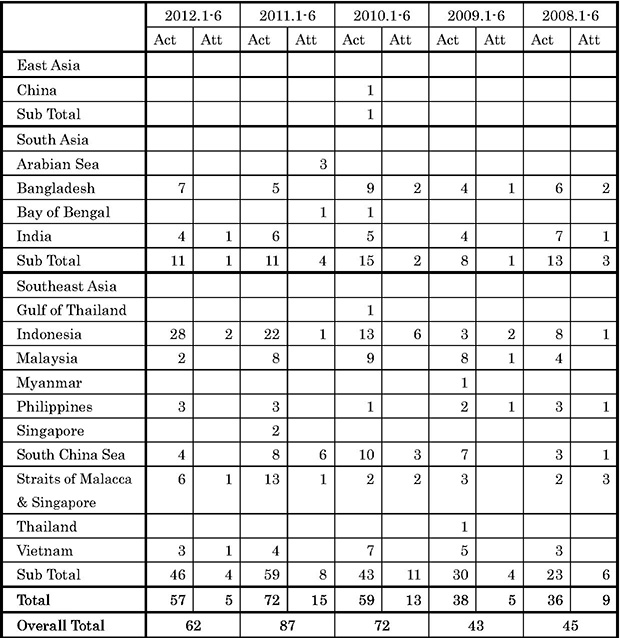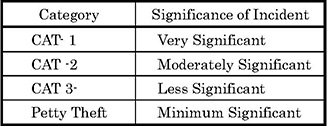Piracy and Armed Robbery against Ships in Asia in the First Half of 2012
Contents
In the end of July 2012, the Information Sharing Center (ISC) of the Regional Cooperation Agreement on Combating Piracy and Armed Robbery against Ships in Asia (ReCAAP), which was established on the basis of ReCAAP, issued the report on the incidents of piracy and armed robberies against ships in Asia for the period of January 1-June 30 in 2012 (hereinafter, the Report). (ReCAAP is an abbreviation of the Regional Cooperation Agreement against Piracy.)
While reports of the International Maritime Bureau (IMB) cover the entire world, ReCAAP’s reports cover the regional areas stretching from the Arabian Sea to northeast Asia via southern rim of the Eurasian continent. In addition, while the IMB gets intelligences from non-government vessels and shipping owners, those of ReCAAP come from information sharing with Focal Point in Hong Kong, Singapore-based Information Sharing Center (ISC) and Information Sharing Web, which is composed of mutual connections with Focal Point. The Focal Points of the respective nations are set at the coast guards, maritime police, ministries in charge of marine transportations, maritime affairs, and/or navy. (In the case of Japan, the focal point is set at Japan Coast Guard.) The focal points of the respective nations are not only coordinating with the law enforcement agencies, navy, port authorities, custom authorities and shipping circle, but also using data from the International Maritime Organization (IMO), IMB, and others.
At present, the ReCAAP consists of the 14 regional nations of India, Sri Lanka, Bangladesh, Myanmar, Thailand, Singapore, Cambodia, Laos, Vietnam, Brunei, Philippines, China, Republic of Korea, Japan and the three non-regional nations of Norway (joining in August 2009), Denmark (joining in July 2010), the Netherlands (joining in November 2010), and the United Kingdom (joining in May 2012). Although Malaysia and Indonesia are non-members, they are conducting exchanges of information with the ISC.
The following are the patterns and trends of the incidents of piracy and armed robbery against the ships noted from the ReCAAP report of the Asian region in the first half of 2012. (January 1 − June 30, 2012)
1. Definition of Piracy and Armed Robbery
Regarding the definition of Piracy and Armed Robbery against Ships, the ISC in ReCAAP accepts the “definition of piracy” in Article 101 of the United Nations Convention on the Law of the Sea (UNCLOS). As for the armed robbery against the vessels, the ISC accepts the definition of the “Code of practice for the Investigation of the Crimes of Piracy and Armed Robbery against Ships” which was adopted by the International Maritime Organization (IMO) in its Assembly session in November 2001. Piracy and Armed Robbery are stipulated in the Article 1 of the ReCAAP Agreement respectively.
2. Numbers and locations of actual and attempted attacks
According to the report, while the number of incidents reached 62 (87 in the same period of 2011), the actual attacks recorded 57 (72 in the same period of 2011) and the rest of those was 5 (15 in the same period of 2011). This means that the incidents decreased by 29% compared with the first half of 2011. As the Table 1 points out the number of incidents in the areas the ReCAAP covers in every first half for the past 5 years, contrary to the fact that the number of incidents increased in Indonesia, the number of attacks decreased in Malaysia, Singapore, the South China Sea and the Strait of Malacca and Singapore, compared with the same period of 2011. Therefore, the number of incidents in the first half of 2012 showed first decrease in the past 4 years.
Table 1: Total number of incidents by location in the first half of each of past five years

Source: Made from data in ReCAAP ISC Half Yearly Report (January 1−June 30, 2012), Table 2, p.10.
Remarks: Act = Actual Incidents, Att = Attempted Incidents
3. Evaluation on significance of incidents
The most distinctive characteristic of the ReCAAP report is that the ISC evaluates significance of each incident in terms of two factors − violence factor and economic factor, and categorize.
In evaluation of the violence factor, the report uses the following criterion, (1) types of weapons used (violence is the most forceful when more highly efficient weapons than knives and others implement are used; (2) treatment of crews (violence is the most intensive if the crew are killed of kidnapped); and (3) numbers of the pirates /robbers who engaged in attacks (in this case, the more the numbers are, the greater the violence develops, and the organized crime will possibly increase.) Assessing the economic factors, the report uses a criterion of evaluating financial values of damaged vessels. In this case, the seriousness is the greatest when ships were hijacked with the cargoes.
For the above reasons, this report classifies all the incidents into the following 4 categories, adding “Petty Theft” to the rest of three.
As the Table 2 categorizes the actual incidents in the every first half for the past 5 years, the incidents categorized into CAT-3 in the last 4 years are divided into the above-mentioned CAT-3 and Petty-Theft. Analyzing the Table 2, it is obvious that the CAT-1 recorded 1 incident during January-June 2012, which is the least for the last 5 years, and the incident involved the hijacking of Tag & Barge at 35nm off Sarawak in the South China Sea on 17 April 2012. According to the report, About 20 pirates boarded the tug boat and the crew was abandoned onto a lift and set adrift on 20 April. On 30 April, the crew was rescued by a passing Vietnamese fishing boat and the Philippine Coast Guard found the drifting barge, while the tug boat is still missing. Other part, the number of incidents on CAT-2 and CAT-3 in the past 3 years has remained mostly consistent and that of Petty Theft shows dramatic decrease from 34 during the same period in 2011.
Table 2: Number of actual incidents by Categories in the first half of each of past 5 years

Source: Made from data in ReCAAP Half Yearly Report (January 1-June 30, 2012), Chart 1, p.7
4. Status of ships
According to the report, of the 57 actual attacks, 13 involved ships while underway and 44 involved ships at anchor. Of the 13 incidents, 1 belongs to CAT-1, 10 belong to CAT-2 and 2 belong to Petty Theft, while of the 44 incidents involved ships at anchor, 9 belong to CAT-2, 15 belong to CAT-3 and 20 belong to Petty Theft. About half of the number of CAT-2 involved ships which were anchoring at the ports and anchorages of Bangladesh, India and Vietnam, and robbers whose number of persons were constituted of 7-9 and >9, were armed with knives and machetes. In the case of incidents involving vessels while underway, robbers were armed with knives, machetes and guns (in 3 of the all) and usually targeted cash, crew’s laptops, mobile phones or cargo.
The 14 CAT-1 incidents for the last 5 years are all while underway. Of the 14 CAT-1 incidents, 11 incidents were conducted by groups of between 7-20 persons and 12 incidents involved them armed with guns. Of the 9 hijackings, 4 incidents involved the loss of cash and crew’s belongings, 1 involved a crew being murdered and 8 involved Tag & Barge which is lucrative, slow speed and low freeboard with cargo onboard. Therefore, the report points out that used Tag & Barge is relatively cheaper compared with new one and the demand for such used vessels has contributed to the increase in incidents involving the hijacking of tug boats and barges in recent years.
From “Intelligence Analysis (July 2012)”
関連記事

